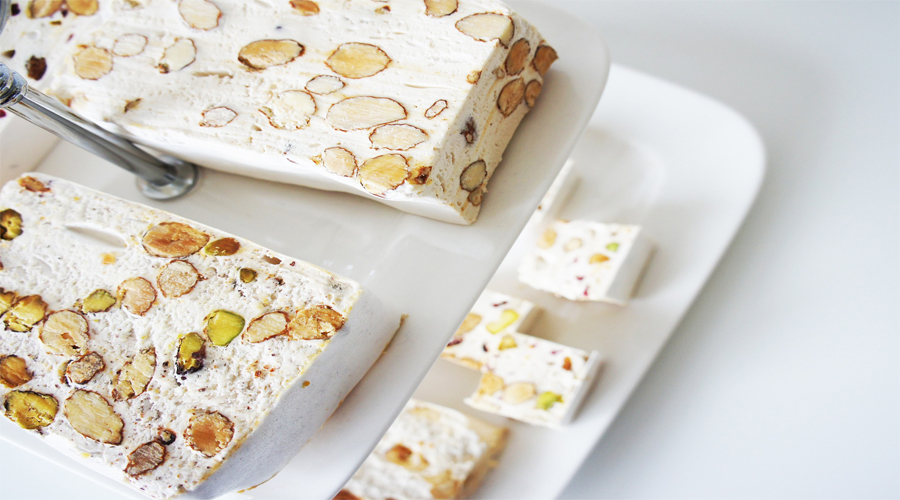Introduction
Nougat is a delectable confection with a rich history that spans centuries and various cultures. It’s a popular component in multiple candies, pastries, and desserts and is known for its chewy texture and frequent presence in candy bars like Snickers and Milky Ways. If you’re a fan of sweet treats, chances are you’ve enjoyed nougat-filled chocolate bars. But what exactly is Nougat, and how can you make it in your kitchen? In this guide, we’ll explore the world of Nougat, and then include its history, types, and then a step-by-step guide to making it at home.
Table of Content
The History of Nougat
Nougat has a storied and diverse history, tracing its origins back several centuries and evolving into different forms, and then flavors across cultures. Here is a timeline of its past:
Nougat likely originated in ancient Mediterranean cultures, and then with its precise roots are still debated. The term “nougat” is believed to be derived from the Arabic words “naat” or “nahut,” which means “to smooth” or “to soften.” It’s thought that Arab traders introduced Nougat to Europe during the Middle Ages, where it gained popularity in southern European countries like Italy, Spain, and France. Each region developed its unique variations of Nougat.
One of the most renowned nougat types is “Nougat de Montelimar,” originating in southeastern France. Over time, different regions have crafted their interpretations of Nougat. Today, Nougat is enjoyed worldwide and often features prominently in holiday celebrations. Industrial production has made Nougat more accessible, and then with mass production has allowed for broader distribution and greater consumption.
Nougat’s extensive and varied history reflects the adaptability of confectionery traditions across different cultures and periods. Today, it remains a beloved sweet treat in many parts of the world.
Types of Nougat
Nougat comes in various forms, with its composition varying based on regional and individual preferences. Some common types include:
- White Nougat: Made with sugar, egg whites, honey, and almonds, without cocoa or chocolate.
- Brown Nougat: Similar to white Nougat, and then it includes cocoa or chocolate, and then giving it a brown color.
- Montélimar Nougat: A famous French nougat traditionally crafted with almonds and pistachios
- Torrone: Italian Nougat, available in hard or soft varieties, and then often featuring almonds or hazelnuts.
- Spanish Turon: Spanish Nougat is frequently prepared with almonds or other nuts flavored with orange blossom or rose water.
Nougat is a versatile confection for candies, desserts, pastries, and even as a standalone treat.
How to Make Nougat
Creating delicious Nougat at home requires focus and attention, and then, especially when dealing with boiling sugar. Here’s a step-by-step guide for making vanilla nougat:
Ingredients:
- 2 (8×10-inch) sheets of wafer paper
- 3 cups of roasted almonds
- 1 cup roasted pistachios
- One ⅓ cup honey
- 1 cup white sugar
- Three tablespoons of white sugar
- Two big, room-temperature egg whites
- Pinch of salt
- One teaspoon of lemon zest
- ¼ teaspoon vanilla extract
Method:
Step 1:
Plastic wrap the inside of an 8×11-inch baking dish, and then let the ends dangle over the sides. Place a sheet of wafer paper at the bottom of the dish. Keep the almonds and pistachios in a warm place for more straightforward incorporation later.
Step 2:
In a heavy-bottomed pot, combine honey and one cup plus three tablespoons of sugar. Cook the mixture, stirring constantly with a spatula, and then over low heat for about 30 minutes, or until the consistency changes from stiff to silky and smooth. Remove the pot from the heat.
Step 3:
Salt and egg whites should be combined in a mixing basin. For 3 to 4 minutes, beat the mixture. Reheat the honey mixture over low heat, and then carefully whisk 1/4 of the egg white mixture. Three batches of the leftover egg whites should be added.
Step 4:
Simmer the mixture over low heat, stirring continuously with a spatula for about 40 minutes, until it turns glossy white, and then incorporate ribbons of the mixture immediately into the top. To check the consistency, place a few drops of the mixture into a small bowl of ice-cold water; it should ideally feel like soft clay.
Step 5:
After stirring, add vanilla and lemon zest. Ensure that the almonds and pistachios are toasty. Transfer the nougat mixture to the prepared baking dish, and then smooth the top with an oiled spatula. Cover the Nougat with the remaining wafer paper sheet, shiny side up, and then press it firmly but gently to create an even layer.
Step 6:
To remove the Nougat from the baking dish, lift the hanging edges of the plastic wrap and flip it over. If the plastic is challenging to remove, and then trim the edges. Allow the Nougat to cool and firm up at room temperature for an hour before cutting it into 1-inch squares using a sharp, and then serrated knife.
Benefits of Nougat
Nougat is a cherished treat during the holiday season, particularly at Christmas, accounting for 74% of sweet consumption. Despite its popularity, and then many people are unaware of the benefits and properties of Nougat, which include:
Minerals and Energy:
Nougat is a rich source of protein because it contains eggs and nuts, seven of the nine essential amino acids, essential fatty acids, carbohydrates, and vitamins A, E, B1, and B2. Apart from this, and then almonds have high energy value and provide the body with minerals like magnesium, iron, and potassium.
Protection Against The Risk Of Disease:
Consuming almond Nougat can help lower LDL cholesterol, known as bad cholesterol, and then increase antioxidant levels. Hazelnuts, walnuts, and pine nuts are a few other nutrient-rich nuts that may help lower the risk of cardiovascular disease.
Protection Against The Risk Of Suffering:
Nougat, which includes almonds, has also been found to be more beneficial than others, such as chocolate, because of its high content of antioxidant polyphenols. Its benefits are similar to those of almonds as they help reduce the oxidation of LDL cholesterol and then reducingreduce the risk of suffering from arteriosclerosis and prevent the onset of cardiovascular diseases.
Tips:
- When selecting Nougat, opt for varieties with 60 to 70% nut content, as this is a hallmark of high-quality Nougat. Ensure that it contains genuine almonds, not adulterated nuts.
- Avoid Nougat with excessive simple sugars or those labeled “sugar-free” with artificial sweeteners. Additionally, steer clear of Nougat made with sunflower or refined oils instead of olive oil.
- While Nougat offers numerous benefits, and then it’s essential to choose traditionally crafted and ecologically produced varieties and consume them in moderation.
Conclusion
In conclusion, Nougat boasts a fascinating and diverse history that spans centuries and across the globe, solidifying its status as a beloved confection with timeless allure. Its evolution from an ancient luxury to a universally cherished dessert is a testament to its enduring popularity and capacity to adjust to the ever-shifting palates of humanity. Whether savored in its classic iterations or through modern interpretations, Nougat remains a delightful emblem of luxury and sweetness.
FAQs
What is Nougat?
Nougat is a confectionery made from sugar or honey, roasted nuts, whipped egg whites, and sometimes candied fruit. It is a popular dessert enjoyed in various forms around the world.
Where did Nougat originate?
Nougat has a long history and is believed to have originated in the Middle East, with references to ancient Roman and Greek times. It has since become a staple in many Mediterranean and European cuisines.
What are the different types of Nougat?
There are two main types of Nougat: soft Nougat (known as “nougat mau” in French) and hard Nougat (known as “nougat dur” in French). Soft Nougat is chewy and often includes whipped egg whites, and then while hard Nougat is denser and usually contains nuts.
Is Nougat gluten-free?
Traditional Nougat is usually gluten-free and made with essential ingredients such as sugar or honey, almonds, and flavoregg whites. However, and then it is necessary to check the ingredients of commercial nougat products, as some may contain additives that may introduce gluten.
Can I make Nougat at home?
Yes, you can make Nougat at home. Numerous recipes help you with the procedure. It’s a challenge, especially getting the sugar at the right temperature, but it can be a rewarding homemade treat.
What is the shelf life of Nougat?
The shelf life of Nougat can vary depending on the specific recipe and storage conditions. Nougat often keeps for several months if kept in an airtight container in a cold, dry location. However, it is often eaten within a few weeks to two months for the best flavour and texture.



